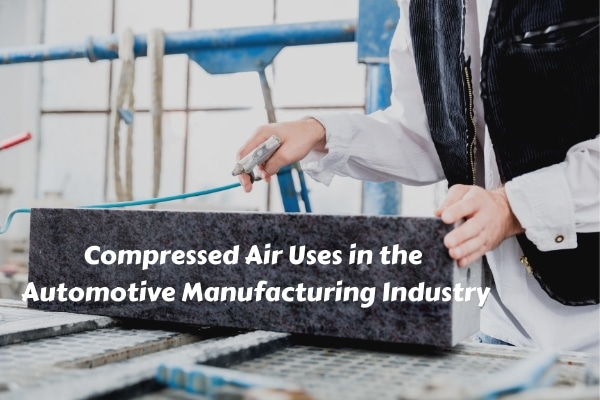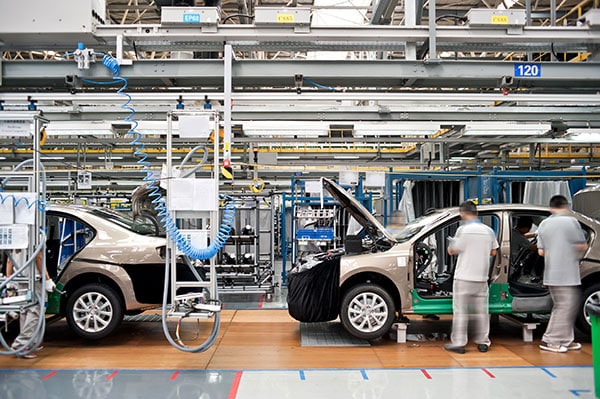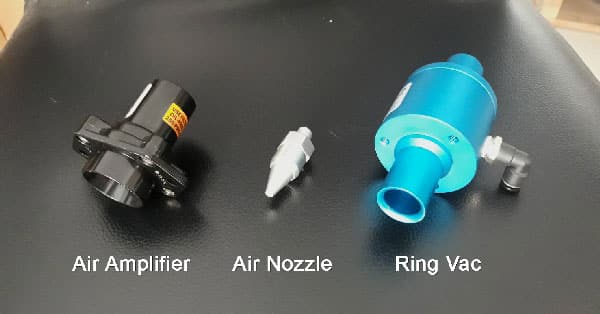
Compressed Air Uses in the Automotive Manufacturing Industry
Advanced computer technologies, automated assembly systems, and high-quality compressed air systems have changed the automotive manufacturing industry. Consumers can purchase safer, more fuel-efficient and reliable vehicles today than ever before. Using compressed air during manufacturing can also save energy and money during assembly.
Uses of Compressed Air in Automotive Manufacturing
Over the last 100 years, automotive manufacturing has been enhanced by the introduction of compressed air in the assembly line to increase worker’s safety and the overall efficiency of the manufacturing plant. It is used as a tool in almost every step in the process of car manufacturing from painting, cleaning, engine and vehicle assembly. It is also used in car tires and in garages/body shops. The typical uses of compressed air in automotive manufacturing include:
- Air operated robots
- Plasma cutting and welding to help speed and reliability
- Air tools are preferred to electronic tools because they are light and easy to use
- Breathing Air filters to increase air quality
- Tire inflation
- Automobile finishing
Cars are now made of more durable and light-weight composite materials including plastics. During assembly, compressed air tools create the auto parts and power the lifting, positioning, and moving, fastening machines. It is used to form critical vehicle components such as stamping door panels and trunks.

Both cleaning and painting processes utilizes compressed air. The bare vehicle is inspected for defects and cleaned before painting. Any contaminants in the air supply will cause expensive re-work, spoilage, and production loss. Clean, dry, oil and contaminant-free compressed air is used to achieve a perfect mirror finish during painting. The compressed air used must have no water or contaminants while painting the car to ensure an even finish. Garages and body shops also use low pressure oil-free compressed air to operate their spray guns. Compressed air is used to agitate the paint in a bath to prevent clumping and mix the color for consistency. Paint is propelled through guns or robots onto a clean metal car body surface using compressed air. To have a consistent reliable paint spray it is critical to choose the right size and type of compressor. Use a compressed air dryer and coalescing filters to remove any naturally occurring moisture to achieve a high-quality paint finish.
Compressed air conveying system has eased heaving lifting on the assembly line that used to be done by humans. The compressed air conveyor systems use clean dry air to create a thin film of air between the work table and the floor. Using a conveying system, parts are sent through the production line. The major components, including gas tank, suspension, axles, breaks, and steering systems, are installed in the car. Tools such as air-powered wrenches fasten and screw components in place. These tools also remove nuts and bolts with an air ratchet. Grinding and cutting metal is done using a small air powered saw. Robotic machinery now uses compressed air to lift, transport, and position heavy components that were once placed by hand. Compressed air is used to install quarter panels, side panels, and roofs in place. Now that the heaving lifting is done by these air operated machines, the assembly line is much more efficient and safer for workers.
The consistency and reliability of a compressed air tools is the reason for their use in body shops. Often air sanders are used to smooth out rough metal pieces. It is recommended to use a pneumatic sander since it weighs less than their electric version and are much more reliable in dusty environments.
Results of Contaminants in Compressed Air During Manufacturing
According to the Compressed Air and Gas Institute (CAGI) and the International Organization for Standardization (ISO), the major contaminants in compressed air are oil, water, microorganisms, and solid particles. Microorganisms are beyond the scope of this article.
ISO 8573 has nine sections that describes compressed air. Section 1 provides a list of contaminants and purity classes. The other sections address sampling techniques and analytical methods for various contaminants.
The following is a list of negative results when compressed air is not clean during automotive manufacturing various types of contaminants.
Oil can:
- Damage equipment
- Cause costly equipment replacement
- Expensive downtime during manufacturing
- Prevent paint adhesion to surfaces
- Paint to crack, flake, or bead
- Create future corrosion or the final finish on a car
When compressed air draws in atmospheric air, it is compressed about a dozen times the normal atmospheric pressure. Atmospheric air naturally contains moisture. The amount of moisture depends on the location (altitude) and season. In these conditions, the water/moisture will begin to condense since compressed air cannot hold the same amount as normal air. This condensation increases as the compressed air moves through the system/gun and cools. These effects are more evident during the summer with higher humidity. Water can:
- Cause moisture to get pulled back into the compressed air system
- Cause negative visual and textural effects on the finish: spotting or “fish-eyes”
- Stick to pipe walls
- Collect in receiver when the air velocity reduces
- Squirt out of the nozzle with the compressed air
- Collect in the low point of the pipe – then is released at once
- Block the path of the compressed air
NOTE: the condensed water would also have other contaminants collecting in the low point of pipes resulting in a nasty mixture of oil and moisture.
Solid Particles, such as rust, dry particles, and aerosols, can:
- Clog nozzles
- Affect the surface of the finished product
Recommended Best Practices for using Compressed Air in Automotive Manufacturing
It is recommended to replace older units with oil-free centrifugal air compressors piped to heat off compression dryers. The energy savings may not be significant but the benefits of improved air quality and reduced maintenance and water cooling costs.
Reduce compressed air consumption by repairing purge controls on dryers and reducing overall demand. Repair compressed air leaks. Replace timer drains. Replace air operated diaphragm pumps with electric ones. This will modernize air compressors into oil free centrifugal technology able to use heat-of-compression dryers. This reduces maintenance and water-cooling costs with long-lasting and efficient air compressors.
The following simple things can be done to remove oil from your compressed air system:
- Multi-staged filtration between the compressor and the tool
- Pneumatic systems can be filtered at the compressor or point of use
The following simple things can be done to remove water from your compressed air system:
- Check your compressor daily
- Fit a water trap or spinner just before your downstream equipment
- Use desiccant air dryers range form -40 degrees to -100 degrees of dew point – which is helpful in painting, printing, and instrument applications.
- Use deliquescent air dryer, which removes the least amount of water vapor and is not usually found in critical applications where air needs to be very dry. It uses salt-like tablets to absorb water vapor from compressed air.
- Manually drain receiver tanks to rid the system of moisture in the air compressor system or use a timer-based drains and pneumatic auto drains. Remember it is illegal to pour untreated condensate down the drain. It is recommended to treat the water before disposing of it.
- Use a pneumatic water separator can remove up to 99.99% of water and oil from the air supply.
- Use a refrigerated air dryer. Chilling air lowers the water between 34 and 40-degree dew-point, which is enough for most applications.
Solid particles can be removed by:
- Dry particulate filtration through direct, inertial, or diffusion movement
- Vapor and aerosol filtration through coalescing or adsorption.
Evaluating the Energy Consumption of Compressed Air

Determining the demand on a compressed air system is important. To calculate the load profile, do the following:
- Interview the plant personnel
- Review historical flow records
- Observe loads on the modicum (little) system
- Count the number of machines requiring compressed air in the plant
- Are there plans for new machines? What are the requirements?
From the above observations determine the current maximum possible peak, current peak, average production flow, and low production flow in cfm.
To determine where your current compressed air system can be enhanced to save money, consider the following:
- Ensure that the current compressors are well maintained, installed, and power efficient units.
- Determine the age of the unit
- Determine their maintenance schedule. Does the equipment need lubrication? Does older equipment need to be replaced?
NOTE: Older units are more difficult and expensive to maintain since the parts are no longer available
Factors to Consider to Size and Install an Air Compressor:
This is a list of items to consider when determining the size of your compressor:
- Air pressure requirements based on manufacturer recommended guidelines. The incorrect pressure results in poor tool and machine performance.
- Air demand (psi and CFM)
- Compressed air storage. A simple guideline is 4 to 5 gallons of air storage per CFM.
Also consider the location of the air compressing equipment. The compressor should be installed on a level surface. Follow the recommended guidelines for spacing:
- Serviceability and access
- Air circulation and ambient room temperature
- Location of Power distribution center
- Ambient air cleanliness
- Keeping the area around the air compressor clean
- Employee health and safety – noise and vibration levels.

Nex Flow recommends several products that can help improve the operations of everything from small body shop projects to the more demanding tasks in the automotive manufacturing site. Here is a look at some of their top-performing products applicable to the automotive manufacturing
- Air amplifiers – compact, low cost air flow movers that are maintenance free. The unit uses the Coandă effect to drain in and amplify air flow up to 17 times results in dramatically reduced noise levels. These devices are used for cooling and venting.
- Air nozzles convert pressure to flow efficiently. All Nex Flow Air Nozzles meet OSHA standard CFR 1910.242(b) for dead end pressure and noise levels are dramatically lower in addition to having lower energy use.
- Ring Vac® air operated conveyors are simple, low cost solution compared to other pneumatic conveying systems. Simply clamp a standard hose size to each end of the Ring-Vac® to create this high energy conveying system. There are no moving parts which lend to maintenance free operation while capacity and flow are controlled with a pressure regulator.





